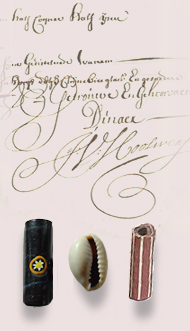
The exhibition is open from
till august 2010, Thrursday till Sunday from 13.00-17.00 hour
NiNsee, Linnaeusstraat 35-F
(across the Tropenmuseum and the Oosterpark) in Amsterdam.
Take trolley nr 9 or bus 22 from Amsterdam Central and get out at 1e van Swindenstraat
€2,50 / Stadpas, Pas 65 Plus, CJP €1,50
Contact the department Research NiNsee. Telephone
++31(0)20 568 8568 or
++31(0)20 5682081 a.bijnaar@ninsee.nl
 With beads, shells, guns, clothing and other goods to exchange, the Dutch between 1600 and 1850, bought slaves in Africa. Also children.
With beads, shells, guns, clothing and other goods to exchange, the Dutch between 1600 and 1850, bought slaves in Africa. Also children.
The visible traces of that trade are still here in the present day Netherlands. Ten years ago in his backyard, Thijs Mathijsse found an old furnace where the glass beads were made. The government’s department for archeological research determined that they are at least four centuries old! They are now on display in this exhibition.
Come see the real beads in the exhibition!
 Cauri shells were also tender in Africa. In fact, they come from the Malediven Islands in the Indian Ocean. In Suriname, these shells are still always called ' pa moniy'. Dutch ships of the East Indies Company obtained large numbers of shells from the Malediven and brought these from the East Indies to the Netherlands, while at the same time carrying nutmeg, pepper and other colonial trade.
Cauri shells were also tender in Africa. In fact, they come from the Malediven Islands in the Indian Ocean. In Suriname, these shells are still always called ' pa moniy'. Dutch ships of the East Indies Company obtained large numbers of shells from the Malediven and brought these from the East Indies to the Netherlands, while at the same time carrying nutmeg, pepper and other colonial trade.
 The ships of the West Indian company and of the later Middelburg Commerce Company used the cauri shells among other things to buy slaves. But sometimes, a ship was lost, such as the Bantam at Vlissingen (1697) and the Reigersbroek at Westkapelle (1738) and the shells washed ashore centuries later on a beach. Such as these, found by the De Jong family on a beach at Middelburg, which they lent for this exhibition, see www.zeeuwsslavernijverleden.nl.
The ships of the West Indian company and of the later Middelburg Commerce Company used the cauri shells among other things to buy slaves. But sometimes, a ship was lost, such as the Bantam at Vlissingen (1697) and the Reigersbroek at Westkapelle (1738) and the shells washed ashore centuries later on a beach. Such as these, found by the De Jong family on a beach at Middelburg, which they lent for this exhibition, see www.zeeuwsslavernijverleden.nl.


